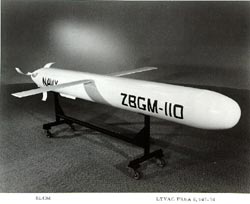|
 The cruise missile program began in 1971 with six companies (including LTV) in competition on a Navy study contract to investigate the feasibility of a submarine launched cruise missile. After several rounds of competitive proposals, two companies (LTV and General Dynamics San Diego) were selected to compete in a fly-off. Each company was to build and test five to six missiles to demonstrate their capabilities. The cruise missile program began in 1971 with six companies (including LTV) in competition on a Navy study contract to investigate the feasibility of a submarine launched cruise missile. After several rounds of competitive proposals, two companies (LTV and General Dynamics San Diego) were selected to compete in a fly-off. Each company was to build and test five to six missiles to demonstrate their capabilities.
There were two engine companies that had products of the correct small size to fit the cruise missiles (Teledyne Engines in Toledo, Ohio, and Williams Engine in Michigan). The Williams company was very small but its engine was in a more mature state of development due to work on very small turbine engines used for the Army’s man maneuver unit. LTV and General Dynamics (GD) both selected the Williams engine but the Navy wanted both engine companies involved in the fly-off competition. The Navy therefore assigned the Teledyne engine to the LTV Cruise Missile, despite unofficial protests by the company.
Another difference between the LTV and GD cruise missiles was the design approaches used to survive the harsh underwater submarine launch. LTV elected to design the missile structure to be rugged enough to withstand the pressures and shocks with no protective covers. GD elected to design a conventional light missile structure and to use a protective dispensable shell for the underwater launch. The GD design approach turned out to be a real advantage during the latter days of the program when air-launched cruise missile versions became popular. For air launch, the protective shell could be eliminated, making a lighter payload than the LTV version.
In the fly-off competition, the LTV flight tests were not completely successful due to an error in programming the timer mechanism used to sense that the missile was ready to transition from underwater flight to normal air flight.
This competition included the first known incident of fullscale powered wind tunnel tests measuring both thrust and drag. LTV performed better in this part of the competition even though the Teledyne engine had difficulty in sustaining long run times in the wind tunnel.
GD won the competition and work by LTV was ended in 1975.
|